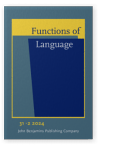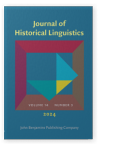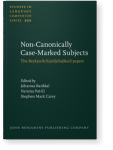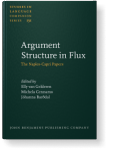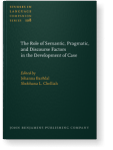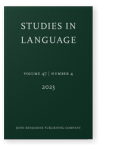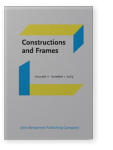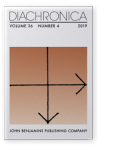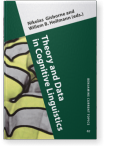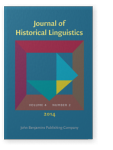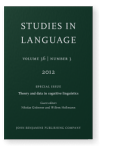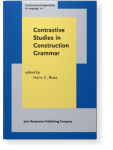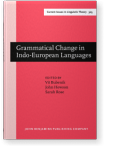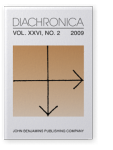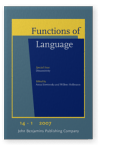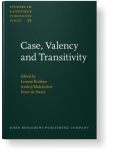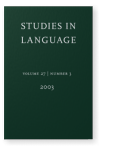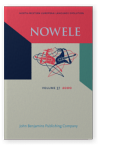Jóhanna Barðdal
List of John Benjamins publications for which Jóhanna Barðdal plays a role.
Journals
ISSN 2210-2116 | E-ISSN 2210-2124
Non-Canonically Case-Marked Subjects: The Reykjavík-Eyjafjallajökull papers
Edited by Jóhanna Barðdal, Na'ama Pat-El and Stephen Mark Carey
[Studies in Language Companion Series, 200] 2018. vi, 280 pp.
Subjects Historical linguistics | Morphology | Semantics | Syntax | Theoretical linguistics
Diachronic Construction Grammar
Edited by Jóhanna Barðdal, Elena Smirnova, Lotte Sommerer and Spike Gildea
[Constructional Approaches to Language, 18] 2015. xi, 263 pp.
Subjects Cognition and language | Historical linguistics | Syntax | Theoretical linguistics
Argument Structure in Flux: The Naples-Capri Papers
Edited by Elly van Gelderen, Jóhanna Barðdal and Michela Cennamo
[Studies in Language Companion Series, 131] 2013. viii, 578 pp.
Subjects Historical linguistics | Semantics | Syntax | Theoretical linguistics
The Role of Semantic, Pragmatic, and Discourse Factors in the Development of Case
Edited by Jóhanna Barðdal and Shobhana L. Chelliah
[Studies in Language Companion Series, 108] 2009. xx, 432 pp.
Subjects Discourse studies | Historical linguistics | Morphology | Pragmatics | Semantics | Syntax | Theoretical linguistics
Productivity: Evidence from Case and Argument Structure in Icelandic
Jóhanna Barðdal
[Constructional Approaches to Language, 8] 2008. xiii, 209 pp.
Subjects Cognition and language | Cognitive linguistics | Germanic linguistics | Historical linguistics | Morphology | Syntax | Theoretical linguistics
2023 From grammaticalization to Diachronic Construction Grammar: A natural evolution of the paradigm Studies in Language 47:4, pp. 743–788 | Article
The term grammaticalization originally denoted a particular outcome of language change (lexis > morphology), then got expanded to practically all studies involving language change, the processes that create such changes, and a theory modeling these. These expansions have been challenged in the… read more
2019 The alternating predicate puzzle: dat -nom vs. nom -dat in Icelandic and German Constructions and Frames 11:1, pp. 107–170 | Article
A long-standing divide between Icelandic and German in the literature takes for granted that there are non-nominative subjects in Icelandic, while corresponding arguments in German have been analyzed as objects (Zaenen et al. 1985; Sigurðsson 1989). This is based on two differences between these… read more
2019 Argument structure, conceptual metaphor and semantic change: How to succeed in Indo-European without really trying Diachronica 36:4, pp. 463–508 | Article
In contrast to grammaticalization studies of lexical verbs changing into auxiliaries, the realm of semantic changes associated with lexical verbs is an understudied area of historical semantics. We concentrate on the emergence of verbs of success from more semantically concrete verbs, uncovering… read more
2018 Chapter 1. Introduction: The Reykjavík-Eyjafjallajökull papers Non-Canonically Case-Marked Subjects: The Reykjavík-Eyjafjallajökull papers, Barðdal, Jóhanna, Na'ama Pat-El and Stephen Mark Carey (eds.), pp. 1–20 | Chapter
2018 Chapter 11. What is a subject: The nature and validity of subject tests Non-Canonically Case-Marked Subjects: The Reykjavík-Eyjafjallajökull papers, Barðdal, Jóhanna, Na'ama Pat-El and Stephen Mark Carey (eds.), pp. 257–274 | Chapter
2018 Chapter 8. Case marking of predicative possession in Vedic: The genitive, the dative, the locative Non-Canonically Case-Marked Subjects: The Reykjavík-Eyjafjallajökull papers, Barðdal, Jóhanna, Na'ama Pat-El and Stephen Mark Carey (eds.), pp. 181–212 | Chapter
Possession is an abstract domain of human conceptualization whose expression may be based on different cognitive structures. Heine (1997) identifies a small set of basic conceptual patterns that express predicative possession across the languages of the world. Vedic has three of these patterns… read more
2015 Diachronic Construction Grammar: Epistemological context, basic assumptions and historical implications Diachronic Construction Grammar, Barðdal, Jóhanna, Elena Smirnova, Lotte Sommerer and Spike Gildea (eds.), pp. 1–50 | Article
The main goal of this chapter is to discuss the value of the Construction Grammar framework to solving perceived problems with diachronic syntax. As such, one part of this chapter provides a condensed review of previous research in diachronic syntax, including a brief discussion of why many… read more
2014 Reconstructing constructional semantics: The dative subject construction in Old Norse-Icelandic, Latin, Ancient Greek, Old Russian and Old Lithuanian Theory and Data in Cognitive Linguistics, Gisborne, Nikolas and Willem B. Hollmann (eds.), pp. 49–85 | Article
As the historical linguistic community is well aware, reconstructing semantics is a notoriously difficult undertaking. Such reconstruction has so far mostly been carried out on lexical items, like words and morphemes, and has not been conducted for larger and more complex linguistic units, which… read more
2014 Editors’ corner Journal of Historical Linguistics 4:2, pp. 159–160 | Article
2013 Argument structure in flux Argument Structure in Flux: The Naples-Capri Papers, Gelderen, Elly van, Jóhanna Barðdal and Michela Cennamo (eds.), pp. 1–12 | Article
2012 Reconstructing constructional semantics: The dative subject construction in Old Norse-Icelandic, Latin, Ancient Greek, Old Russian and Old Lithuanian Theory and data in cognitive linguistics, Gisborne, Nikolas and Willem B. Hollmann (eds.), pp. 511–547 | Article
As the historical linguistic community is well aware, reconstructing semantics is a notoriously difficult undertaking. Such reconstruction has so far mostly been carried out on lexical items, like words and morphemes, and has not been conducted for larger and more complex linguistic units, which… read more
2010 Revising Talmy’s typological classification of complex event constructions Contrastive Studies in Construction Grammar, Boas, Hans C. (ed.), pp. 201–236 | Article
2009 The development of case in Germanic The Role of Semantic, Pragmatic, and Discourse Factors in the Development of Case, Barðdal, Jóhanna and Shobhana L. Chelliah (eds.), pp. 123–159 | Article
In this article five existing explanations for the loss of case morphology in the Germanic languages are examined. These are (1) phonological erosion, (2) a change from synthetic to analytic language type, (3) a change from free to fixed word order, (4) the development of the definite article, and… read more
2009 Introduction: The role of semantic, pragmatic and discourse factors in the development of case The Role of Semantic, Pragmatic, and Discourse Factors in the Development of Case, Barðdal, Jóhanna and Shobhana L. Chelliah (eds.), pp. ix–xx | Article
2009 The origin of the oblique-subject construction: An Indo-European comparison Grammatical Change in Indo-European Languages: Papers presented at the workshop on Indo-European Linguistics at the XVIIIth International Conference on Historical Linguistics, Montreal, 2007, Bubenik, Vit, John Hewson and Sarah Rose (eds.), pp. 179–193 | Article
2009 Typological changes in the evolution of Indo-European syntax? Diachronica 26:2, pp. 253–273 | Article
2007 The semantic and lexical range of the ditransitive construction in the history of (North) Germanic Ditransitivity, Siewierska, Anna and Willem B. Hollmann (eds.), pp. 9–30 | Article
Current analyses of the semantic structure of the ditransitive construction in English assume that the construction consists of approximately nine semantic subconstructions, namely those of actual, intended, retained and metaphorical transfer (and some corresponding subconstructions). An… read more
2006 Control infinitives and case in Germanic: ‘Performance error’ or marginally acceptable constructions? Case, Valency and Transitivity, Kulikov, Leonid, Andrej L. Malchukov and Peter de Swart (eds.), pp. 147–177 | Article
2000 Oblique Subjects in Old Scandinavian NOWELE Volume 37 (September 2000), pp. 25–51 | Article
